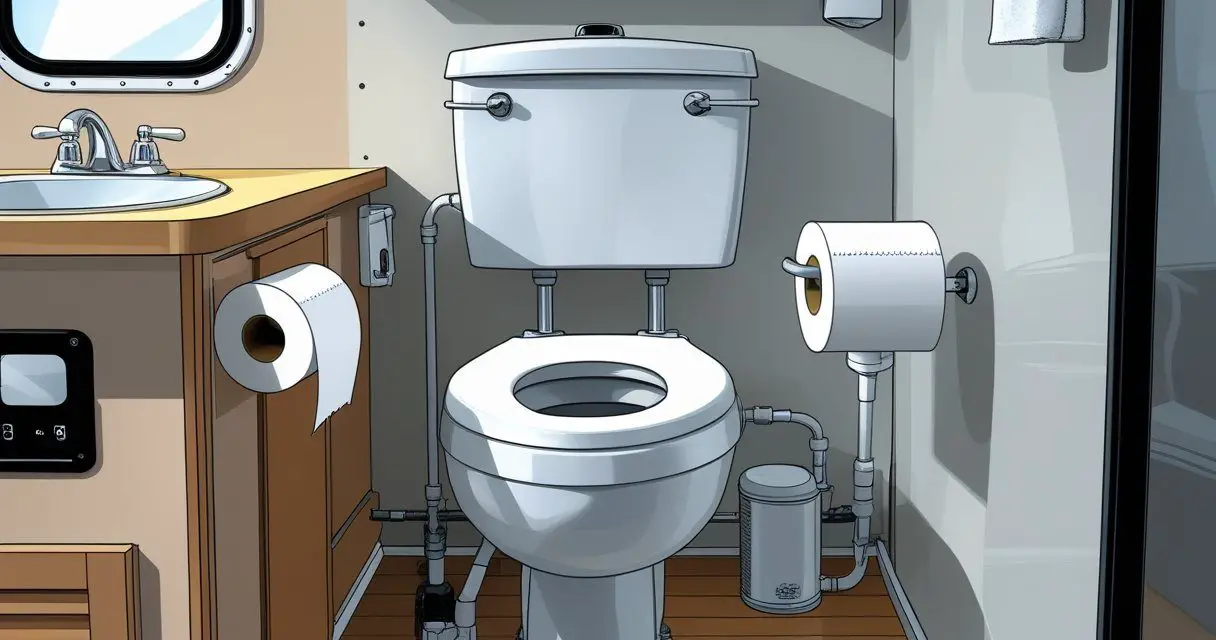Would you like to save this article?
When you start traveling in an RV, one of the first questions that comes up is what kind of toilet paper you can safely use. The shelves are full of “RV-safe” options, but they often cost more and aren’t always easy to find.
You can use regular toilet paper in an RV, but only if it breaks down quickly and won’t clog your holding tank.
The key difference is that RV plumbing works with a holding tank, not a powerful sewer system like at home. Thick or slow-dissolving paper can cause clogs, odors, and extra maintenance.
Choosing the right type of toilet paper helps you avoid those problems and keeps your system running smoothly. You don’t have to stick to RV-specific brands, but you do need to know which regular options are safe.
With the right approach, you can save money, simplify your supply runs, and still protect your RV’s plumbing system.
Key Takeaways
- Regular toilet paper can be used if it dissolves quickly
- RV plumbing requires careful toilet paper choices to avoid clogs
- Some regular and septic-safe brands work well for RV use
Can Regular Toilet Paper Be Used in an RV?
You can use regular toilet paper in an RV if it breaks down quickly enough to avoid clogs in the black water tank. The key is not the label on the package but how the paper behaves once flushed into the RV septic system.
Risks of Using Regular Toilet Paper
The main risk of using conventional toilet paper in an RV toilet is clogging. Unlike a household sewer system, your RV holding tank has limited space and relies on water and movement to break waste down.
If toilet paper does not dissolve well, it can form clumps. These clumps may block the toilet opening, the tank outlet, or the sewer hose when you empty the tank.
Even if the clog is minor, it can cause slow draining or unpleasant odors inside your RV. In severe cases, you may need to manually clear the blockage, which is both messy and time-consuming.
Certain products like thick, ultra-soft, or multi-ply toilet paper tend to break down slowly. These types increase the chance of buildup and should be avoided in RV toilets.
Factors That Affect Toilet Paper Suitability
Not all regular toilet paper is the same. Some brands dissolve quickly, while others are designed for strength and thickness, which makes them harder to break down in an RV septic system.
Key factors include:
- Ply count: Single-ply usually dissolves faster than 2-ply or 3-ply.
- Absorbency: Highly absorbent paper tends to stay intact longer.
- Additives: Lotions, scents, or extra-soft coatings can slow the breakdown process.
Another factor is how much you use at one time. Even RV-safe toilet paper can cause problems if you flush large wads.
Using moderate amounts and enough water when flushing helps keep the black water tank clear. Brands labeled septic-safe or rapid-dissolving are often better choices for RV toilets, but you should still test them before relying on them.
Testing Regular Toilet Paper for RV Use
A simple jar test can help you check if your preferred toilet paper is safe for your RV holding tank.
- Fill a clear jar halfway with water.
- Place 2–3 squares of toilet paper inside.
- Close the lid and shake for 5–10 seconds.
If the paper breaks apart into small pieces, it will likely work in your RV septic system. If it stays in large clumps, it may cause blockages.
You can compare different brands side by side using this test. Many RVers find that common household brands like Scott 1000 or Kirkland dissolve well enough for long-term use.
How RV Toilet Paper Differs from Regular Toilet Paper
The main differences come down to how quickly the paper breaks apart in water, whether it is safe for septic systems, and how it feels compared to what you normally use at home. These factors matter because RV toilets and holding tanks work differently than household plumbing.
Dissolvability and Breakdown Speed
RV-specific toilet paper is designed to dissolve quickly in water. This helps prevent clogs in the black water tank and makes dumping waste easier.
Regular toilet paper often takes longer to break down, especially if it is thick or multi-ply. If you use paper that doesn’t dissolve fast enough, it can build up inside the tank.
This may cause blockages, slow draining, or odors. To avoid this, you should look for RV-safe or septic-safe toilet paper that passes a simple jar test: place a few sheets in water, shake, and check if it breaks apart within minutes.
Some brands of household toilet paper, like Scott 1,000 or certain Kirkland rolls, are thin enough to dissolve quickly. Others, such as extra-thick or “ultra-strong” products, may stay intact too long and create problems.
Biodegradability and Septic Safety
Most RV-safe toilet paper is labeled as septic-safe or biodegradable. This means it not only dissolves in water but also breaks down naturally in waste systems.
Since your RV relies on a holding tank rather than city plumbing, the paper’s ability to decompose matters. Using biodegradable toilet paper reduces the risk of buildup inside the tank.
It also works better with tank treatments that help break down waste and control odors. Some regular toilet papers are septic-safe as well, but not all are made with RV systems in mind.
RV-specific toilet paper is often made from recycled fibers or cellulose that are engineered to disintegrate faster. Regular paper, especially premium brands, may contain stronger fibers that resist breaking down.
Comfort and Strength Comparisons
Comfort and strength are where you notice the biggest trade-offs. Regular toilet paper is usually softer, thicker, and stronger because it is designed for daily household use.
RV toilet paper, while safe for your tank, can feel thinner and less plush. You may find that RV-specific toilet paper tears more easily.
This is intentional, as weaker paper dissolves faster. Some users prefer to sacrifice comfort for peace of mind, while others test and choose thinner household brands that balance softness with quick breakdown.
If comfort is important, you can try single-ply septic-safe household paper. It often feels closer to what you use at home while still being safe for your RV system.
The key is to avoid ultra-thick or quilted products that resist dissolving.
Septic-Safe and Alternative Toilet Paper Options for RVs
When choosing toilet paper for your RV, you need to think about how well it breaks down, how much water it requires, and whether it increases the risk of clogs. Some options dissolve faster than others, and a few alternatives can help reduce strain on your black water tank.
Septic-Safe Toilet Paper in RVs
Septic-safe toilet paper is often a good choice for RV use. It is designed to dissolve quickly in septic tanks, which makes it less likely to cause blockages in an RV’s smaller plumbing system.
Many RV owners use brands like Scott or Kirkland, which are labeled septic-safe and widely available. You should still be cautious, because not all septic-safe toilet paper breaks down at the same rate.
Thicker varieties may still leave residue in your black water tank. To reduce problems, pair septic-safe toilet paper with tank cleaners or enzyme treatments that help break down waste.
If you want to test a brand, place a few sheets in a jar of water, shake it, and see if it dissolves.
Single-Ply vs. Multi-Ply Options
Single-ply toilet paper usually dissolves faster than multi-ply, making it more suitable for RV systems. Multi-ply sheets are thicker and stronger, which may feel more comfortable but often take longer to break down.
This can increase the chance of buildup in your black tank.
Here’s a quick comparison:
| Type | Dissolves Quickly | Comfort | Risk of Clogs |
|---|---|---|---|
| Single-Ply | Yes | Lower | Low |
| Multi-Ply | Slower | Higher | Higher |
If you value comfort, you can still use multi-ply paper, but you’ll need to flush with extra water and possibly add tank treatments. If you want fewer worries about clogs, stick with single-ply septic-safe toilet paper.
Flushable Wipes and Other Alternatives
Flushable wipes may seem convenient, but they often do not break down as quickly as toilet paper. Even if labeled flushable, many wipes can stick to the inside of hoses and tanks.
Over time, this can lead to clogs or slow draining. If you use wipes, it’s best to dispose of them in the trash instead of flushing.
Other alternatives include biodegradable toilet paper made for camping, which is thinner and designed to dissolve quickly. Some RVers also use tank treatments alongside regular toilet paper to help reduce risks, but this requires more water and chemicals.
Choosing the right option depends on your comfort level, water use, and how much maintenance you want to do on your RV’s septic system.
Choosing the Best Toilet Paper Brands for Your RV
You need toilet paper that breaks down quickly, prevents clogs in your black tank, and keeps your sensors working correctly. Both RV-specific and some household brands can meet these needs if you choose carefully.
Popular RV Toilet Paper Brands
RV toilet paper brands are designed to dissolve faster than most household options. This makes them safer for black tanks and reduces the risk of clogs or false sensor readings.
Common RV toilet paper brands include:
- Camco – Single-ply, septic-safe, quick-dissolving.
- Thetford Aqua-Soft – Two-ply, soft, dissolves quickly, sold in multi-roll packs.
- Freedom Living – Biodegradable, two-ply, breaks down in minutes.
- Valterra – Two-ply, tested for rapid breakdown.
- Firebelly Outfitters – Biodegradable, unscented, dye-free.
These brands often cost more than regular toilet paper, but they are made specifically for RV and marine systems. If you want to avoid clogging issues, they are a reliable choice.
Household Brands That Work in RVs
Several household brands also dissolve well enough for RV use. These can be more affordable and easier to find in local stores.
Examples of household toilet paper safe for RVs include:
- Scott Rapid-Dissolving – Designed for RVs and boats, single-ply, FSC-certified.
- Seventh Generation – Two-ply, recycled paper, fragrance-free.
- Cottonelle – Certain types dissolve well; check packaging for septic-safe labeling.
- Angel Soft – Some versions break down quickly enough for RV systems.
- Kirkland (Costco) – Many RV owners report it works without clogging tanks.
When using household brands, always test them first. Place a few sheets in a jar of water, shake it, and see if it breaks down.
If it doesn’t dissolve, avoid using it in your RV.
Considerations for Sensitive RV Systems
Your RV’s plumbing is more sensitive than a home toilet system. Even with safe brands, you should use less paper per flush and plenty of water to help it move into the black tank.
If your RV has older or smaller tanks, stick to single-ply or fast-dissolving paper. Scott Rapid-Dissolving or Camco are good options for these setups.
Using biodegradable toilet paper helps reduce buildup and makes tank cleaning easier. Pairing the right paper with regular tank treatments will keep your system running smoothly and reduce maintenance problems.
Maintaining Your RV Toilet and Holding Tank
Keeping your RV bathroom in good working order depends on preventing clogs, flushing the right way, and treating the black water tank with the right products. Small habits make a big difference in keeping your system clean and avoiding costly repairs.
Preventing Clogs and Buildup
Your black water tank is smaller and more sensitive than a household sewer system. Paper and waste can build up quickly if you do not take steps to manage it.
Using septic-safe or RV-approved toilet paper helps it dissolve faster and reduces the chance of blockages. Avoid flushing items that do not break down easily.
This includes wipes, paper towels, and hygiene products. Even if a product is labeled “flushable,” it is not safe for an RV toilet.
It also helps to add extra water when you flush. Water keeps waste moving and prevents solids from sticking to the tank walls.
Without enough water, you may end up with a hardened layer of waste, sometimes called a “pyramid plug.” Regular tank cleaning is another key step.
Flushing the tank with clean water after dumping helps remove leftover debris. You can also use a tank rinser or built-in flush system if your RV has one.
Proper Flushing Techniques
How you flush makes a big difference in the long-term health of your system. Always hold down the foot pedal long enough to send plenty of water into the black water tank.
A quick flush may leave solids behind and cause odors later. Before using the toilet for the first time after dumping, add a few gallons of water to the empty tank.
This creates a base layer that helps waste flow instead of sticking to the bottom. If your RV toilet has a sprayer, use it to rinse the bowl and push solids down.
This keeps the bowl clean and reduces buildup in the line. When dumping, wait until the black tank is at least two-thirds full.
A fuller tank allows stronger flow, which helps waste clear out more effectively. Dumping too often with small amounts of waste can leave residue behind.
Using RV Toilet Chemicals
RV toilet chemicals help manage odors and break down waste in the black water tank. These treatments come in liquid, powder, or drop-in pod form, making them easy to use.
Choose a product labeled safe for septic systems and RV plumbing. The main purpose of these chemicals is to speed up the breakdown of toilet paper and waste and control unpleasant smells inside your RV bathroom.
Some products also include enzymes or bacteria that digest solids naturally. Follow the directions on the package for the right amount to add.
The dose often depends on the size of your tank. After adding the chemical, pour in a few gallons of water to activate it.
You should add a new dose each time you dump and rinse the tank. In hot weather or heavy use, you may need to refresh the treatment more often.
Tips for Responsible RV Toilet Paper Use
Using regular toilet paper in your RV is possible, but how you manage water, waste, and habits will determine if your system stays trouble-free. Paying attention to how much water you flush, where you dispose of paper, and how you guide others using your RV bathroom makes a big difference.
Water Conservation and Usage
Water plays a key role in breaking down toilet paper inside the RV toilet and black tank. Without enough water, even septic-safe or RV-safe paper can clump and cause blockages.
You should always flush with more water than you might at home. Hold the flush pedal down for several seconds to ensure paper moves fully into the tank.
If you have a foot-pedal toilet, press it halfway first to add water, then flush completely. Avoid flushing small amounts of water with large amounts of paper.
This practice increases the chance of clogs. Instead, balance usage by keeping the tank contents diluted.
A simple tip is to pour an extra quart of water into the RV toilet after dumping. This creates a base layer of liquid that helps future waste and paper break down faster.
Disposal Practices When Not Flushing
Not all paper products belong in the RV bathroom toilet. Items like facial tissues, paper towels, or wipes do not dissolve properly and can block the black tank valve.
Even products labeled “flushable wipes” should not be flushed. If you want to reduce clogs further, keep a small covered trash bin near the toilet.
You can use it for excess toilet paper or for guests who may use more than the system can handle. When camping in areas with limited dump access, this method helps extend the time before you need to empty the tank.
It also reduces the amount of water you need for flushing, which is useful if you are conserving fresh water. Always use bags with secure closures to control odor if you choose this method.
Dispose of them in campground trash bins or other approved waste containers.
Educating Guests and New RVers
Guests often treat an RV bathroom like a regular household toilet. Without guidance, they may use too much paper, flush wipes, or fail to use enough water.
Take a few minutes to explain how the RV toilet works. Show them how to hold the pedal long enough for a full flush.
If your RV has a dual-pedal system, demonstrate how to add water before flushing.
It helps to post a short list of rules inside the bathroom. For example:
- Use only toilet paper.
- Hold pedal down for 5–10 seconds.
- Do not flush wipes or tissues.





